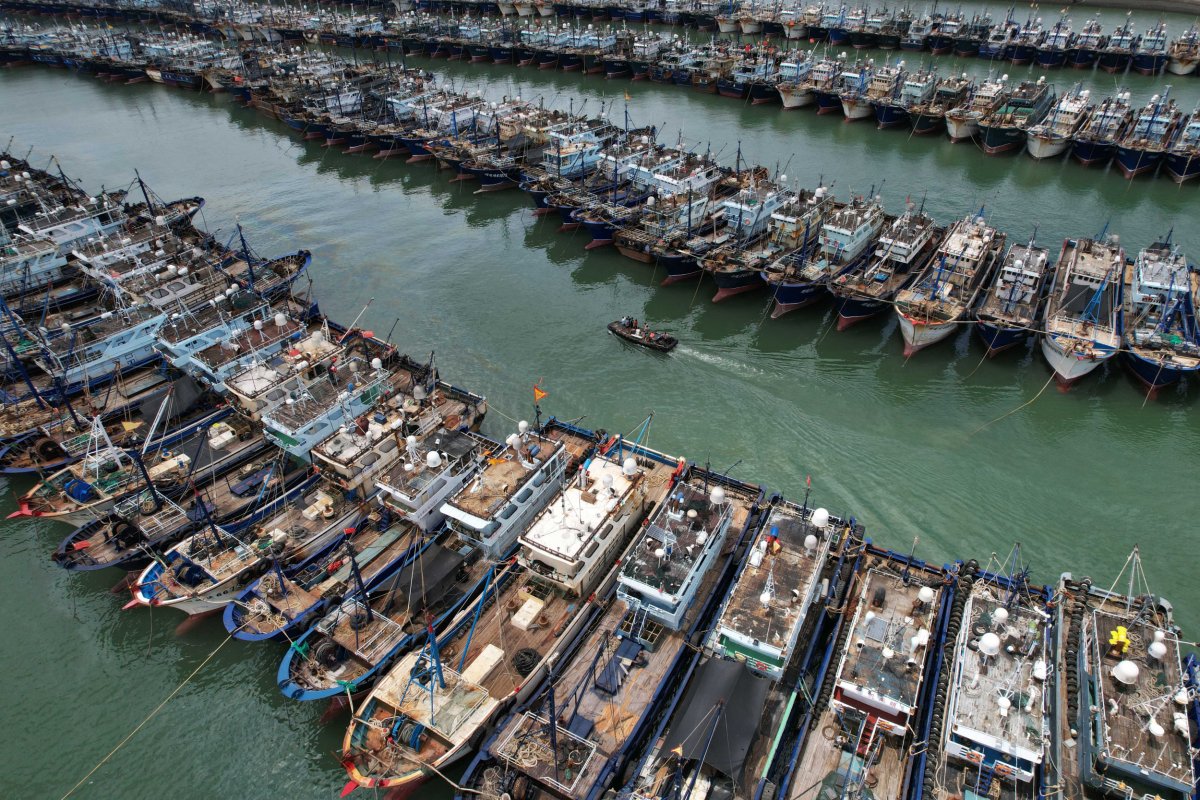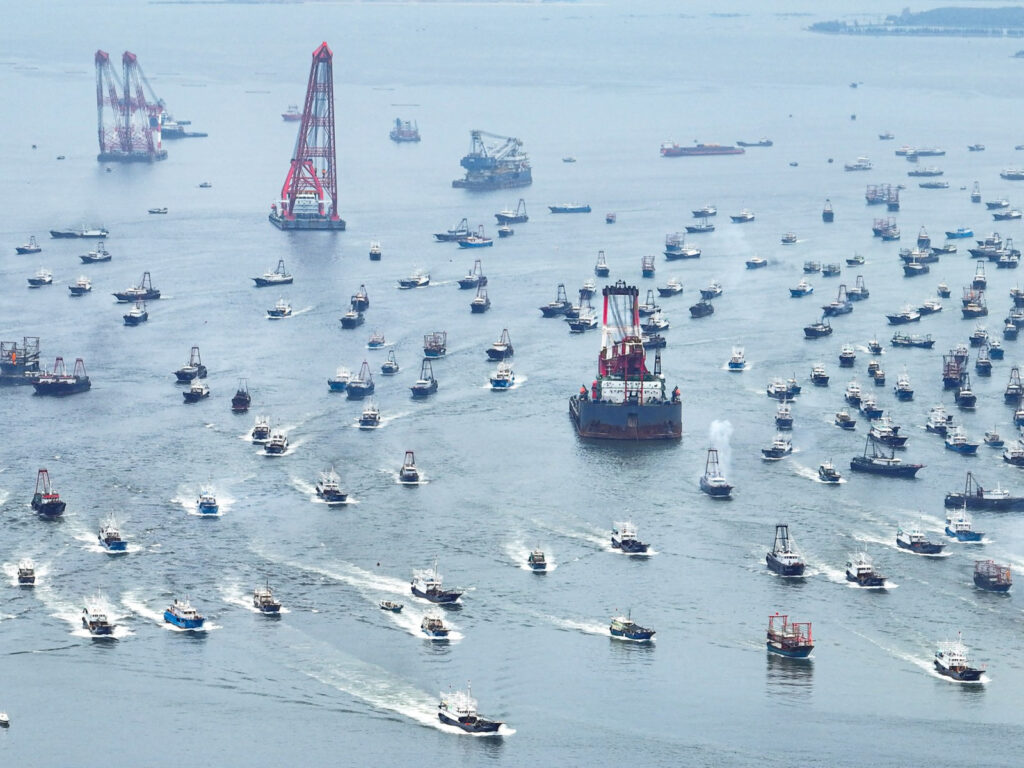China’s alleged abuse of the world’s oceans was examined in recent studies into its vast fishing fleet, which is accused of destroying maritime ecosystems far from its shores and perpetuating the industry’s forced labor practices.
China-flagged ships on the high seas were involved in “theft on a grand scale, unrestricted warfare on natural resources,” said a report by the SeaLight project, which says it uses “commercially available technology to shed light on the maritime ‘gray zone.'”
Illegal, unregulated and unreported (IUU) fishing by Chinese vessels was happening throughout the Asia-Pacific, including within other countries’ exclusive economic zones (EEZ), according to SeaLight, which is under Stanford’s Gordian Knot Center for National Security Innovation.
An EEZ, as defined in the 1982 U.N. Convention on the Law of the Sea, is a maritime zone that extends 200 miles beyond a country’s coastline, within which that nation has the exclusive right to exploit underwater resources.
SeaLight author Kevin Edes cited Adm. Linda Fagan, the U.S. Coast Guard commandant, who said earlier this year that small island nations lacked sufficient resources to enforce their EEZs against more powerful states like China.
China has the world’s largest commercial fishing fleet at over half a million vessels. It is “one of the worst offenders” of IUU fishing, Fagan said. Included in the definition—the unlawful capture of fish, giant clams and coral from other countries’ fishing areas.
“Maritime thievery must be identified and denounced on the regional and global stages,” Edes wrote. “Only when nations increase cooperation in maritime patrols and information sharing while pursuing legal and economical consequences will vital national resources be protected from predatory fishing fleets.”
The Chinese Foreign Ministry didn’t return Newsweek request for comment before publication.
China’s fleet is responsible for a sizable amount of the world’s bottom-trawl fishing, according to Ray Powell, director of SeaLight. The country accounts for 28 percent of the worldwide trawling catch. Meanwhile, half of the 3,000 fishing vessels that operate beyond China’s coastal waters are estimated to be engaged in trawling, according to research published last year by the Global Journal of Biology, Agriculture and Health Sciences.
In bottom trawling, giant nets are dragged along the seafloor, ensnaring target species along with many others. “All of the bottom-dwelling plants and animals are affected, if not outright destroyed, by tearing up root systems or animal burrows,” the U.S. Geological Survey says.
The practice is depleting global fish stocks, according to SeaLight, which has also documented the Chinese fishing fleet’s intimidation of other countries’ ships through “swarming.” Just last week, China deployed its coast guard and maritime militia to attempt to block a Philippine supply mission to the Manila held-Second Thomas Shoal in the South China Sea.
In its attempts to enforce sweeping territorial and maritime claims in the energy-rich sea—at the expense of half a dozen other claimant states—Beijing has undergone a yearslong artificial island-building campaign on the orders of President Xi Jinping.
From 2013-2015, China reclaimed over 3,000 acres of land on seven different reefs in the contested Spratly Islands, damaging the local ecosystem and putting a dent in the hauls of local fisheries, according to the U.S.-China Economic and Security Review Commission. And despite a public pledge to the contrary, China has fully militarized at least three artificial islands in the area.
The SeaLight report called for “collaborative and bold solutions” to China’s gray zone encroachment in the South China Sea.
“The Philippines Coast Guard has sent its ships and aircraft out to photograph Chinese vessel swarms at places like Sabina Shoal and Iroquois Reef, often with embedded reporters aboard. It has also sent out teams of photographers to document the visibly degraded conditions of the marine ecosystems at those locations,” Powell told Newsweek.

A separate report found China to be complicit in deep-sea fishing’s foreign forced labor practices—the seafood industry’s long-held dirty secret.
A quarter of fishing boats accused of forced labor were Chinese, while another quarter sailed under European flags, according a study published on Wednesday by the Financial Transparency Coalition.
According to the U.N.’s International Labor Organization, risk indicators of forced labor include debt-bonded labor, abusive living and working conditions, restrictions on employees’ movements, and deception—luring new labor with promises of better working conditions.
Fishing fleet laborers were especially at risk of exploitation on distant water fishing fleets, where they spend months at sea, far from any legal oversight or intervention.
Of the 138 fishing companies accused of forced labor, 35 percent were Chinese, 10 percent were Taiwanese, 8 percent were Thai, 6 percent were South Korean, and 5 percent were Spanish, according to the research.
Taiwan, despite its small size, has the world’s second-largest distant water fishing fleet after China. And the self-ruled island also has a spotty track record on fishing practices and migrant rights.
The U.S.’ National Oceanic and Atmospheric Administration this year named Taiwan on its list of offenders due to IUU fishing practices by Taiwanese companies, and because of Taipei’s lackluster regulations on wildlife protection. China was also on this list.
The Financial Transparency Coalition, among its recommendations, said countries should request and publicize information on fishing vessel management, operators and owners.
Countries should ratify existing international conventions on fisheries and forced labor prevention, its report said. Governments should alsoconsider forced labor offenses in fisheries to be “predicate offenses,” or crimes whose proceeds are then laundered, it added.
Source : Newsweek


